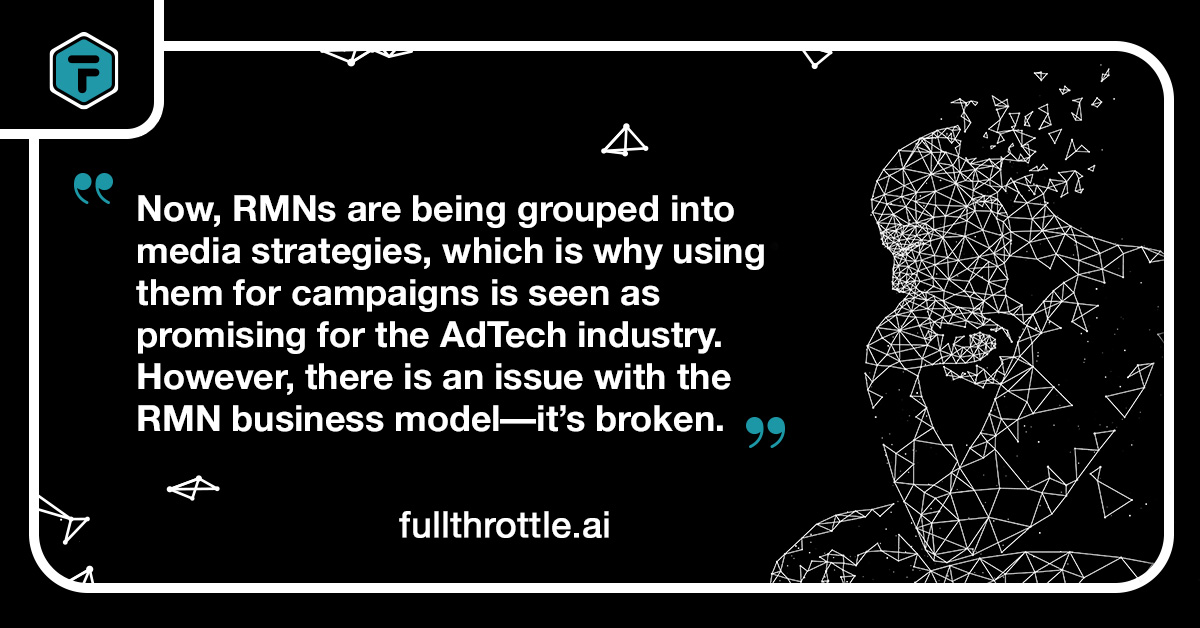
Fixing the Broken RMN Business Model
Retail media networks (RMN) are currently considered a large area of growth in the AdTech industry. As third-party data is in a race to the bottom, the RMN model is a new way to protect the value of first-party data with a way to monetize data.
What Are Retail Media Networks?
Retail media networks are a way for brands to access retailer first-party data. They are becoming more and more popular now with the digital age and growth of walled gardens.
The network refers to the collection of digital channels owned by the retailer, which is then sold to other businesses to use for advertising and marketing. Since it is becoming more difficult to buy third-party data, this is a viable alternative. It also maintains privacy compliance, since it’s the retailer’s first-party data, which they do not share. Their first-party data never leaves their firewall and they don’t sell it. By doing this, they can keep their data high quality and private, especially as they run campaigns on behalf of the brand partners.
For the longest time, the only way to monetize data was through creating third-party audiences and selling them over an exchange. Selling third-party data has become very commoditized. However, as privacy concerns grow, quality third-party data becomes harder to obtain.
This is why retailers started to monetize their first-party data. Retailers will offer other companies their first-party data for a fee and run the campaigns for these other companies.
Now, RMNs are being grouped into media strategies, which is why using them for campaigns is seen as promising for the AdTech industry. [2] However, there is an issue with the RMN business model––it’s broken.
Why Is the Retail Media Network Business Model Broken?
In reference to brick-and-mortar RMN, the main reason the retail media network model is broken is due to the timeliness of their data. Most of the brick-and-mortar RMNs are using past customer purchase data, such as previous customer information and previous item purchases. While history is a great predictor of future purchasing, this does not mean they are able to create a rich profile of the folks on websites and currently in-market.
For example, if a shopper buys a specific brand of toothpaste from Walgreens while signed into their account and then a week later, they return it for a different product without signing in, Walgreens is missing information on this user. Additionally, if this user has already purchased toothpaste, a retargeting campaign won’t work on this user since they won’t need toothpaste anymore. Therefore, running campaigns on past-transactions or based on user history won’t lead to more conversions.
Since these RMN are using past data, at some point they will run into a scalability issue. Not to mention, there is behavior outside of Google Chrome on other major browsers that RMNs are unable to track due to cookie deprecation.
With the help of new technology such as fullthrottle.aiTM, these businesses would be able to build a better profile of their shoppers––both logged in and purchasing––as well as those browsing on the site without being logged in. Using technology like fullthrottle.aiTM also provides an insider view of the buying cycle.
In order for the retail media network model to thrive, it’s important for them to expand their assets to current, timely data. fullthrottle.aiTM can help retail media networks identify shoppers on-site, without cookies or IP addresses. When fullthrottle.aiTM is placed on an e-commerce website, it increases conversions through retargeting and in-market audiences.
Retail Media Networks Are Building Walled Gardens
Every retailer and every publisher is creating these walled gardens where other brands are not granted access to the data. However, if brands pay these retailers or publishers, they’ll run the brands’ campaigns and use the data.
This is the opposite of what the programmatic industry has been pitching for the past ten years. The programmatic industry was built on third-party cookies rather than buying audiences, since it was more efficient than buying content on websites. As cookies are dying, the AdTech industry is moving to the other side, which is contextual targeting. Contextual targeting is targeting folks based on the content they’re seeing on-site.
Programmatic is audience based as opposed to content based. Another way to break this down is that programmatic advertising is open, whereas walled gardens are closed.
These walled gardens the RMNs are creating are inefficient, since retailers and publishers don’t have a history of running campaigns like companies designed to run campaigns. It is also important to keep in mind that most retailers traditionally are not media buyers or media managers.
This leaves brands in a catch-22––they’re likely not getting quality campaigns, but it’s supposedly better-quality data and supposedly makes up for the lack of data collected by third-party cookies.
Using Your Own In-Market Audiences
Retail media networks and fullthrottle.aiTM could work together to build the ultimate customer profile. If RMNs used the data fullthrottle.ai’s technology collected, they could then offer it to the brands they work with, so the data is timely and relevant for converting in-market shoppers in real time.
At the end of the day, a retailer’s first-party data is your second- or third-party data. It’s not data you’ve collected from consumers who are interested in your product. It’s not hyper-relevant to your business.
My point isn’t to discourage you completely away from RNMs. In fact, there is a way to utilize their data, as long as you supplement it with your own first-party data. Once you identify in-market shoppers on your website, you can build a richer profile of your target audience with a retail media network.
At fullthrottle.aiTM, we’ve solved the timeliness issue. With fullthrottle.ai’s platform, you no longer have to rely on previous purchases and guesswork. You can see exactly who is currently shopping for your product or service. Schedule a demo today to discover what fullthrottle.aiTM can do for you.


